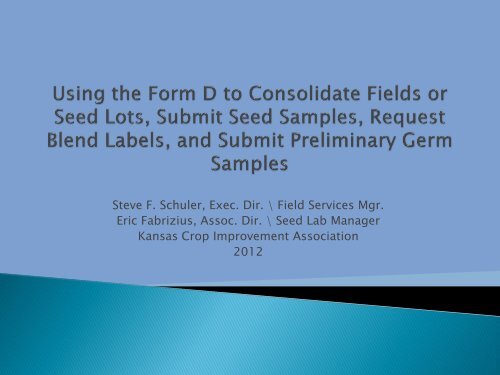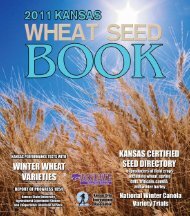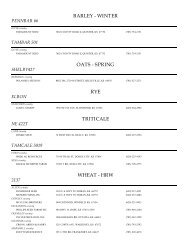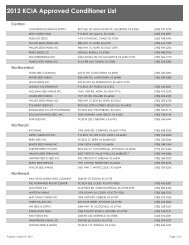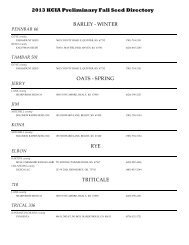Steve F. Schuler, Exec. Dir. \ Field Services Mgr. Eric Fabrizius ...
Steve F. Schuler, Exec. Dir. \ Field Services Mgr. Eric Fabrizius ...
Steve F. Schuler, Exec. Dir. \ Field Services Mgr. Eric Fabrizius ...
Create successful ePaper yourself
Turn your PDF publications into a flip-book with our unique Google optimized e-Paper software.
<strong>Steve</strong> F. <strong>Schuler</strong>, <strong>Exec</strong>. <strong>Dir</strong>. \ <strong>Field</strong> <strong>Services</strong> <strong>Mgr</strong>.<br />
<strong>Eric</strong> <strong>Fabrizius</strong>, Assoc. <strong>Dir</strong>. \ Seed Lab Manager<br />
Kansas Crop Improvement Association<br />
2012
KCIA Certification Standards do not limit maximum seed lot size but<br />
require that each 5000 bushels, or portion thereof, of a seed lot be<br />
sampled and tested.<br />
May or may not wish to consolidate seed into lots larger than 5000 bu.<br />
Advantages of lot sizes greater than 5000 bushels:<br />
• More efficient use of bin space, handling.<br />
• Ease of record keeping, i.e. one certification number for<br />
labeling, etc.<br />
Disadvantages of lot sizes greater than 5000 bushels:<br />
• Seed lot takes on characteristics of the poorest component.<br />
• Rejection of all seed based on lab results of one 5000 bu.<br />
portion.<br />
• KDA “Stop Sale” affects whole seed lot.
“Form D Number” – Used to identify sample(s)<br />
and will become the Certification Number of the<br />
seed represented upon receiving certification.<br />
List all <strong>Field</strong> (A) numbers, Form D. numbers, or Transfer Kit<br />
numbers from which the seed represented by this Form D.<br />
originates.<br />
Enter ONLY the actual bushels represented by this Form D<br />
and its accompanying sample(s), NOT the total bushels for<br />
the field, transfer kit, etc. The Total is pre-cleaned bushels<br />
unless tested samples with individual Form D. #s are<br />
consolidated.<br />
Seed Conditioned, enter the total from Section 1. if the<br />
whole lot is cleaned, or an amount not less than 50 bushels<br />
if a provisional Certificate is desired. Cleanout is the<br />
difference between Seed Conditioned and the Amount after<br />
cleaning. Amount after cleaning is the amount actually<br />
cleaned at sample submission.<br />
Specify testing requested. Choose Standard certification<br />
test for all testing needed to complete certification for the<br />
seed lot. If submitting a preliminary germ sample, the<br />
Form D. number to be used for the final seed lot must<br />
accompany the sample.<br />
This amount in bushels represents the Total in section 1.<br />
minus the total Cleanout = total Amount after cleaning. If<br />
this amount is greater than 5000 bushels, additional<br />
samples, each accompanied by a copy of the same Form D,<br />
must be submitted. If the whole lot is not cleaned and a<br />
provisional certificate is sought, this amount will be the<br />
Total in section 1 minus the estimated total cleanout.
• Consolidation of fields must be reported to<br />
KCIA. This is often done when submitting<br />
samples for testing.<br />
• Consolidated seed assumes the poorest or<br />
most restrictive quality of the component<br />
fields.<br />
• Avoid contaminating good seed with bad.
• Use the Form D. Request for Testing and<br />
Certificate of Inspection to submit sample(s)<br />
• A seed sample can represent a maximum of 5000<br />
bu.<br />
• 5000 bushels = One Sample + One Form D.<br />
• More than 5000 bu. – Multiple Form Ds or<br />
photocopies of one Form D needed depending on<br />
when consolidation is done.
<strong>Field</strong> Consolidation–less than 5000 bu.<br />
D00001<br />
A00001<br />
A00002<br />
A00003<br />
2150<br />
622<br />
2200<br />
5072<br />
White caps, splits<br />
I.M. Seedcleaner, Inc.<br />
5072<br />
497.2<br />
4595<br />
I.M. Seedcleaner 7/25/08<br />
4595<br />
Sam Seedproducer 7/27/08
• Consolidate seed prior to testing<br />
-OR-<br />
• Consolidate seed after testing<br />
•
• Each sample sent with a copy of the Form D that<br />
describes the final consolidated lot. Each sample<br />
labeled with Form D number and sample number<br />
(i.e. “D00001, #1”).<br />
• Advantages:<br />
• Saves bin space<br />
• Simplifies recordkeeping by reducing number of seed lots<br />
• Disadvantages:<br />
• Quality of seed not known prior to consolidating.<br />
• Rejected subsample = Rejected Seed lot.
Consolidating Seed Samples Prior To Testing<br />
A00001<br />
A00002<br />
A00003<br />
A00004<br />
A00005<br />
2150<br />
622<br />
2200<br />
4800<br />
5200<br />
14,972<br />
I.M. Seedcleaner, Inc.<br />
14,972<br />
1497.2<br />
13,474<br />
SAMPLE D00001 #1<br />
5000 bu.<br />
SAMPLE D00001 #2<br />
5000 bu.<br />
I.M. Seedcleaner 7/25/08<br />
Photocopy D00001<br />
SAMPLE D00001 #3<br />
3474 bu.<br />
D00001=13474 bu.<br />
13,474<br />
Original D00001<br />
Photocopy D00001
• Each tested seed lot has a Form D number<br />
associated with it under which it was tested.<br />
• Submit an additional Form D listing the Form D<br />
numbers of each tested seed lot to be<br />
consolidated. Certification number = Final Form<br />
D number.<br />
• Advantage: Quality of seed known prior to<br />
consolidating.
D00001-4475 bu. D00002 – 5000 bu.<br />
Consolidation of tested<br />
seed lots into one<br />
larger seed lot.<br />
D00003 -3999 bu.<br />
D00004 – 13,474 bu.
Tested Seed lot Consolidation –<br />
sell as<br />
D00004<br />
D00001<br />
D00002<br />
D00003<br />
4475<br />
5000<br />
3999<br />
13474<br />
13,474<br />
Sam Seedproducer 7/27/08
Blends<br />
• Unless registered with the Kansas Department of<br />
Agriculture, a blend label must list components by % and<br />
variety in decreasing order of presence.<br />
• KCIA must issue a unique certification number for the<br />
blend.<br />
• Certification number for the blend is requested using the<br />
Form D prior to selling the blend.<br />
• Label analysis is a composite of the lowest seed quality<br />
parameters, i.e. lowest germ, highest inert, highest other<br />
crop, etc. or, a sample of the blend may be submitted for<br />
testing.
Requesting a Blend Certification Number<br />
Using the Form D.
‣ Submit a sample of pre-conditioned seed to obtain a germination<br />
that may be used for labeling. Sample must be identified with the<br />
Form D that will be used to submit the final CSI sample.<br />
Advantages:<br />
- Sample from pre-conditioned seed<br />
- Permits an early start to bagging and labeling<br />
Disadvantages:<br />
- Certification not final until CSI sample testing is<br />
completed<br />
- Can’t sell on a preliminary germ<br />
- May have to re-label bags, if final germ is below the<br />
preliminary germ.
Preliminary Germs<br />
A00001<br />
A00002<br />
A00003<br />
D00001<br />
2150<br />
622<br />
2200<br />
Final CSI Sample<br />
D00001<br />
4972<br />
Preliminary Sample<br />
D00001<br />
Sam Seedproducer 7/25/08<br />
Original Copy D00001<br />
Photocopy D00001


